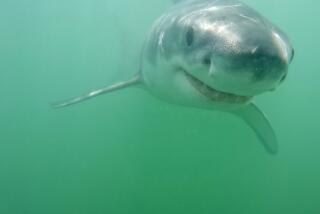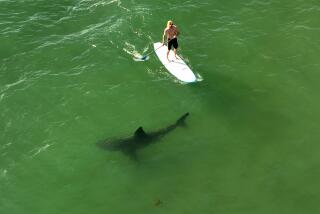Baby âJawsâ Is a Star
MONTEREY, Calif. â A baby great white shark, caught in a fishermanâs net off Huntington Beach and displayed at the Monterey Bay Aquarium, set a record Friday for number of days spent in captivity.
Aquariums have long tried to exhibit great white sharks, only to be forced to release them into the ocean when they refused to eat. But after 17 days here, the 52-inch, 62-pound female is still gulping down salmon fillets, mackerel and sardines, a sign that she is healthy and adapting to her new home.
Less than a year old, the newcomer is swimming in the aquariumâs million-gallon Outer Bay exhibit, getting along well with her neighbors, which include giant bluefin tuna that make her look a bit like a runt.
âItâs a remarkable thing,â said Chris Lowe, a scientist who teaches shark behavior and physiology at Cal State Long Beachâs shark lab. âItâs eating on average 2% to 4% of its body weight, and that is a really good sign that this animal has rapidly adapted to the tank and to captivity and is doing well.â
The shark was caught inadvertently in a halibut fishermanâs gillnet three to six miles off Huntington Beach on Aug. 20 and turned over to the aquarium, which had been seeking one for several years.
Aquarium officials and marine scientists hope to change attitudes toward the animal, which is perhaps best known for its horrific starring role in the âJawsâ movies and is widely regarded as one of the most fearsome predators on Earth.
Aquarium officials hope to make their newest acquisition -- the only great white shark currently on display anywhere -- the centerpiece of a program to educate the public about how shark populations are declining due to trade in their fins and teeth.
About 85,000 people have visited the aquarium since the shark was put on display Sept. 15 -- a 54% increase in visitation compared with the same period in 2003 -- and traffic on its website has roughly doubled, aquarium spokesman Ken Peterson said.
Many visitors are surprised at the size of the fish: about that of an 8-year-old child. âThat canât be a great white shark,â one schoolboy shouted in disbelief as the animal glided past in the ceiling-high tank. âItâs too small!â
Scientists say keeping the young shark in captivity might help solve many mysteries about the biggest predatory fish in the sea, such as how much they eat and how fast they grow. For three years, Stanford University researchers, working with the aquarium and other partners, have been tagging and tracking white sharks in the wild. One thing theyâve learned was that they swim between California and Hawaii.
The captive shark, which has no nickname, is swimming with bluefin tuna five times its weight, as well as barracuda, bonitos, sunfish, sea turtles, stingrays and three other species of shark that are about its present size, including hammerheads.
Aquarium officials said that because the shark is fed regularly, there is little chance that she will make a meal of her neighbors. One day, she ate a healthy 2.9 pounds of salmon fillet. On seven of the 17 days, including Friday, she hasnât eaten anything.
No other great white shark has been displayed for more than 16 days. In 1968, an aquarium in Sydney, Australia, killed one after it ate the exhibitâs other fish and raised concern that it would become too aggressive toward divers who sometimes worked in the tank.
Despite their image, white sharks havenât been known to menace humans very often. When a 50-year-old swimmer at Avila Beach was killed by a 15- to 18-footer a year ago, it was the first such death in California since 1994. A 13-year-old surfer lost her arm while surfing off Kauai last November, but that attack came from a tiger shark. Another surfer was killed off Maui in April by an unknown species of shark.
During the first few days the shark was on display at the aquarium, she was the object of grisly jokes. Why wasnât there an arm or a leg dangling from her mouth? visitors asked. But aquarium workers say after just a couple weeks, they have noticed a different reaction, with visitors inquiring about the fishâs health.
âPeople respond much better to babies than they do to adults,â Lowe said. âSo maybe this white shark, which looks like a shrunk-down miniature of an adult, will change peopleâs perceptions, and they will realize that it is just like any other animal on the planet.â
It is illegal to harvest white sharks in U.S. and California waters, as well as in Australia. Beginning today, representatives from 166 nations are gathering in Bangkok, Thailand, to decide whether to list the species as endangered and ban international trade.
Aquarium officials said they are monitoring the newcomerâs condition around the clock and deciding day to day whether to keep her on display or release her into the wild.
One reason for the success may be that the shark probably is more adaptable than an adult. It also spent 25 days getting used to captivity in an ocean holding pen off Malibu before being trucked to Monterey.
In time, she may outgrow her new home. Members of her species can grow to be more than 20 feet long. But no one is predicting the length of her stay. Randy Kochevar, the aquariumâs science communications manager, said experts have no idea how quickly the animals grow.
âMy suspicion is that weâll release the shark long before she stops growing,â Peterson said.
âItâs remarkable that weâve gone in just two weeks from wondering whether a white shark would survive in an aquarium for more than a few days to wondering about what could happen several years down the road if she continues to thrive and grow.â
More to Read
Sign up for Essential California
The most important California stories and recommendations in your inbox every morning.
You may occasionally receive promotional content from the Los Angeles Times.










